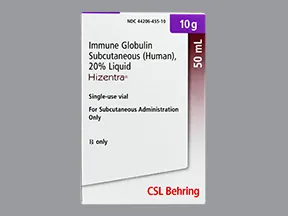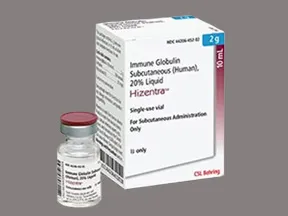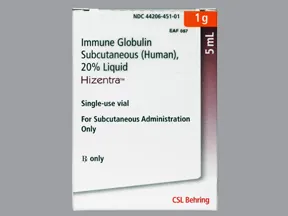Do not share this medication with others.
Lab and/or medical tests (such as IgG levels, complete blood count) should be performed periodically to monitor your progress. Consult your doctor for more details.
This medication is used to boost the body's natural defense system against infection in persons with a weakened immune system (primary immune deficiency). Immune globulin contains natural substances called antibodies (a type called IgG) that come from healthy human blood (plasma). These antibodies help protect your body against infections and help you to fight an infection if you get sick.
Some immune globulin products may also be used to treat a certain nerve disorder (chronic inflammatory demyelinating polyneuropathy-CIDP).
This medication may rarely cause serious blood clots (such as pulmonary embolism, stroke, heart attack, deep vein thrombosis). You may be at increased risk for blood clots if you are an older adult, are severely dehydrated, have a catheter in a vein close to your heart for administering medications, or have a history of blood clots, heart/blood vessel disease, heart failure, stroke, or if you are immobile (such as very long plane flights or bedridden). If you use estrogen-containing products, these may also increase your risk. Before using this medication, discuss the risks and benefits and if you have any of these conditions, report them to your doctor or pharmacist.
The risk of blood clots may be decreased by infusing this medication more slowly or by using a less concentrated form of this medication if available. Being adequately hydrated before receiving this medication may also help reduce this risk.
Get medical help right away if any of these side effects occur: shortness of breath/rapid breathing, chest/jaw/left arm pain, unusual sweating, sudden dizziness/fainting, pain/swelling/warmth in the arm/leg, sudden/severe headache, trouble speaking, weakness on one side of the body, sudden vision changes, or confusion.
Read the Patient Information Leaflet and Instructions for Use if available from your pharmacist before you start using immune globulin and each time you get a refill. If you have any questions, consult your doctor or pharmacist.
This medication is given slowly by injection under the skin (subcutaneous infusion) as directed by your doctor. Depending on your product, this medication may be given as often as every day up to once every 2 weeks. Follow your doctor's instructions carefully on how often to receive this medication. The dosage is based on your medical condition, weight, and response to treatment.
If you are giving this medication yourself, learn all preparation and usage instructions for the medication and infusion pump from your health care professional and the product directions. Do not inject this medication into a blood vessel. Learn how to store and discard needles and medical supplies safely. If any of the information is unclear, consult your health care professional.
Do not shake this medication. Before using, check this product visually for particles or discoloration. If either is present, do not use the liquid. Change the location of the injection site(s) with each dose to avoid problem areas under the skin. The recommended sites for injection are the abdomen, thighs, upper arms, and hips.
Patients who are getting immune globulin for the first time, those who are switched from another brand of immune globulin, or those who have not received immune globulin in the past 2 months may be at risk of developing fever, chills, nausea, vomiting, and rarely shock. It is recommended that these patients receive their first dose of this medication in the doctor's office/clinic so they can be monitored for these side effects.
Use this medication regularly to get the most benefit from it. To help you remember, mark your calendar with a reminder of which days you should receive the medication.
See also Warning section.
Mild swelling, redness, or itching at the injection site may occur and usually lessen as your body adjusts to the medication. Headache, upset stomach, fever, nausea, diarrhea, sore throat, cough, or pain may also occur. If any of these effects last or get worse, tell your doctor or pharmacist promptly.
Remember that this medication has been prescribed because your doctor has judged that the benefit to you is greater than the risk of side effects. Many people using this medication do not have serious side effects.
Tell your doctor right away if you have any serious side effects, including: signs of kidney problems (such as change in the amount of urine), sudden weight gain, fast heartbeat.
Get medical help right away if you have any very serious side effects, including: severe headache, stiff neck, eye pain, sensitivity to light, trouble breathing.
A very serious allergic reaction to this drug is rare. However, get medical help right away if you notice any symptoms of a serious allergic reaction, including: rash, itching/swelling (especially of the face/tongue/throat), severe dizziness, trouble breathing.
This is not a complete list of possible side effects. If you notice other effects not listed above, contact your doctor or pharmacist.
In the US - Call your doctor for medical advice about side effects. You may report side effects to FDA at 1-800-FDA-1088 or at www.fda.gov/medwatch.
In Canada - Call your doctor for medical advice about side effects. You may report side effects to Health Canada at 1-866-234-2345.
See also Warning section.
Before using this medication, tell your doctor or pharmacist if you are allergic to it; or to other immune globulin products; or if you have any other allergies. This product may contain inactive ingredients (such as polysorbate 80), which can cause allergic reactions or other problems. Talk to your pharmacist for more details.
Before using this medication, tell your doctor or pharmacist your medical history, especially of: certain immune system problems (selective immunoglobulin A deficiency with known antibody against IgA, monoclonal gammopathy), kidney disease, diabetes, current blood infection, severe loss of body fluids (dehydration).
Some immune globulin products are made with maltose. This substance can cause false high blood sugar levels when your blood sugar is normal or even low. If you have diabetes, check with your pharmacist whether the product you are using contains maltose and whether your blood sugar testing supplies will work with this product. Rarely, serious problems have occurred when too much insulin was given because of false high sugar readings or when low blood sugar went untreated.
Tell your doctor of any recent or planned immunizations/vaccinations. This medication may prevent a good response to certain live viral vaccines (such as measles, mumps, rubella, varicella). If you have recently received any of these vaccines, your doctor may have you tested for a response or have you vaccinated again later. If you plan on getting any of these vaccines, your doctor will instruct you about the best time to receive them so you get a good response.
This medication is made from human blood. Even though the blood is carefully tested, and this medication goes through a special manufacturing process, there is an extremely small chance that you may get infections from the medication (for example, viruses such as hepatitis). Consult your doctor or pharmacist for more information.
Before having surgery, tell your doctor or dentist about all the products you use (including prescription drugs, nonprescription drugs, and herbal products).
During pregnancy, this medication should be used only when clearly needed. Discuss the risks and benefits with your doctor.
It is unknown if this drug passes into breast milk. Consult your doctor before breastfeeding.
See also Warning section.
Drug interactions may change how your medications work or increase your risk for serious side effects. This document does not contain all possible drug interactions. Keep a list of all the products you use (including prescription/nonprescription drugs and herbal products) and share it with your doctor and pharmacist. Do not start, stop, or change the dosage of any medicines without your doctor's approval.
This medication may interfere with certain tests (including certain blood sugar tests, blood type, Coombs test), possibly causing false test results. This can lead to serious (possibly fatal) consequences. Tell all lab personnel and all your doctors and pharmacists that you use this medication, and which type of blood sugar testing strips you use.
If someone has overdosed and has serious symptoms such as passing out or trouble breathing, call 911. Otherwise, call a poison control center right away. US residents can call their local poison control center at 1-800-222-1222. Canada residents can call a provincial poison control center.
Do not share this medication with others.
Lab and/or medical tests (such as IgG levels, complete blood count) should be performed periodically to monitor your progress. Consult your doctor for more details.
It is important to get each dose of this medication as scheduled. If you miss a dose, ask your doctor or pharmacist right away for a new dosing schedule. Do not double the dose to catch up.
Different brands of this medication have different storage needs. Check the product package for instructions on how to store your brand, or ask your pharmacist. Once a vial is opened, throw away any unused portion right away. Do not freeze. Keep all medications away from children and pets.
Do not flush medications down the toilet or pour them into a drain unless instructed to do so. Properly discard this product when it is expired or no longer needed. Consult your pharmacist or local waste disposal company.

Hizentra 10 gram/50 mL (20 %) subcutaneous solution
Color: pale yellowShape: Imprint:This medicine is a pale yellow, clear, vial

Hizentra 4 gram/20 mL (20 %) subcutaneous solution
Color: colorlessShape: Imprint:This medicine is a pale yellow, clear, vial

Hizentra 2 gram/10 mL (20 %) subcutaneous solution
Color: pale yellowShape: Imprint:This medicine is a pale yellow, clear, vial

Hizentra 1 gram/5 mL (20 %) subcutaneous solution
Color: colorlessShape: Imprint:This medicine is a pale yellow, clear, vial